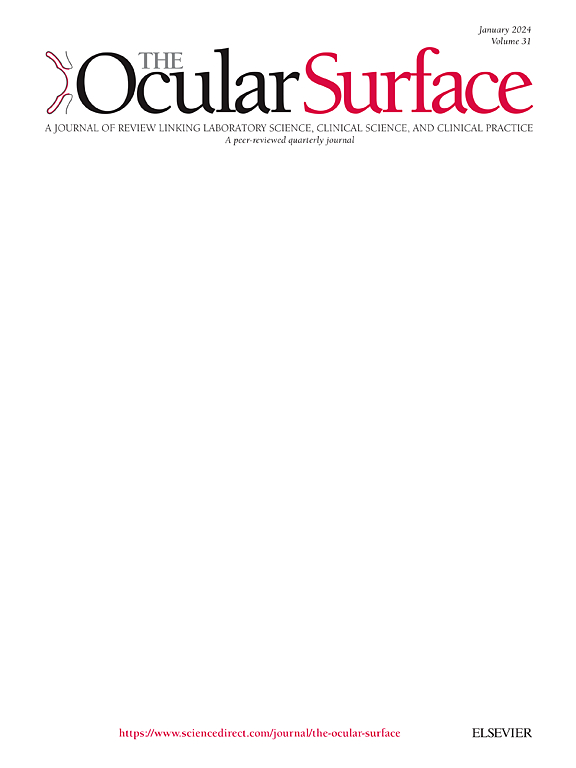小鼠角膜神经损伤的早期髓样细胞浸润和亚群特异性巨噬细胞反应
IF 5.6
1区 医学
Q1 OPHTHALMOLOGY
引用次数: 0
摘要
角膜神经纤维和常驻巨噬细胞形成了一个特殊的微环境,对损伤后组织的完整性和恢复至关重要。本研究旨在阐明角膜神经损伤后的早期免疫动力学,重点关注骨髓细胞浸润和常驻巨噬细胞亚群转移。本文章由计算机程序翻译,如有差异,请以英文原文为准。
Early myeloid cell infiltration and subset-specific macrophage responses in murine corneal nerve injury
Purpose
Corneal nerve fibers and resident macrophages form a specialized microenvironment essential for tissue integrity and recovery after injury. This study aims to elucidate the early immune dynamics following corneal nerve injury, focusing on myeloid cell infiltration and resident macrophage subset shifts.
Methods
Using a murine circular nerve-cut model, we tracked immune responses for 21 days, with a focus on the first 12 h post-injury. Confocal imaging was used to assess corneal nerve density, while flow cytometry quantified infiltrating and resident immune cell populations. Transcriptomic profiling was performed at 3 and 6 h post-injury to analyze inflammatory gene expression, and in vitro experiments examined the effects of short-term nerve growth factor (NGF) exposure on macrophage polarization.
Results
Confocal imaging showed a rapid decrease in corneal nerve density, followed by progressive regeneration. Flow cytometry revealed a surge in Ly6C+ myeloid cells at 3–6 h post-injury, predominantly in the central cornea, with an early tendency toward M2-like polarization. Resident macrophages exhibited distinct responses: M2-like and undifferentiated subsets declined, while M1-like cells were proportionally maintained, indicating divergent but complementary roles during the initial inflammatory phase. Transcriptomic profiling showed significant upregulation of inflammatory genes along with a transient increase in Ngf and compensatory anti-inflammatory signaling. In vitro, short-term NGF exposure enhanced both M1-and M2-like polarization, mirroring in vivo activation patterns.
Conclusion
Early myeloid cell infiltration and macrophage subset dynamics contribute to the initial neuroinflammatory response and may influence subsequent repair processes, highlighting the potential for immune modulation in corneal nerve regeneration.
求助全文
通过发布文献求助,成功后即可免费获取论文全文。
去求助
来源期刊

Ocular Surface
医学-眼科学
CiteScore
11.60
自引率
14.10%
发文量
97
审稿时长
39 days
期刊介绍:
The Ocular Surface, a quarterly, a peer-reviewed journal, is an authoritative resource that integrates and interprets major findings in diverse fields related to the ocular surface, including ophthalmology, optometry, genetics, molecular biology, pharmacology, immunology, infectious disease, and epidemiology. Its critical review articles cover the most current knowledge on medical and surgical management of ocular surface pathology, new understandings of ocular surface physiology, the meaning of recent discoveries on how the ocular surface responds to injury and disease, and updates on drug and device development. The journal also publishes select original research reports and articles describing cutting-edge techniques and technology in the field.
Benefits to authors
We also provide many author benefits, such as free PDFs, a liberal copyright policy, special discounts on Elsevier publications and much more. Please click here for more information on our author services.
Please see our Guide for Authors for information on article submission. If you require any further information or help, please visit our Support Center
 求助内容:
求助内容: 应助结果提醒方式:
应助结果提醒方式:


